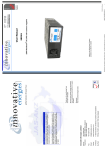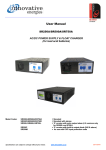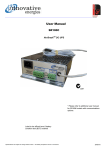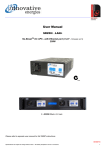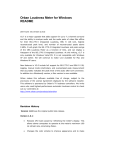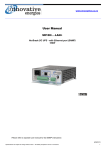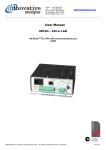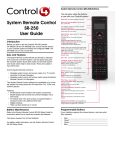Download user manual - Innovative Energies Ltd
Transcript
User Manual SR250C/SR500C/SR750C No-BreakTM DC UPS SR250C SR500C / SR750C (with optional V/I meter shown) REFER TO BACK PAGE FOR CUSTOMISED MODELS Specifications are subject to change without notice. No liability accepted for errors or omissions. 28/08/2015 Safety The user is responsible for ensuring that input and output wiring segregation complies with local standards and that in the use of the equipment, access is confined to operators and service personnel. A low resistance earth connection is essential to ensure safety and additionally, satisfactory EMI suppression (see below). HAZARDOUS VOLTAGES EXIST WITHIN A POWER SUPPLY ENCLOSURE AND ANY REPAIRS MUST BE CARRIED OUT BY A QUALIFIED SERVICEPERSON. Electrical Strength Tests Components within the power supply responsible for providing the safety barrier between input and output are constructed to provide electrical isolation as required by the relevant standard. However EMI filtering components could be damaged as result of excessively long high voltage tests between input, output and ground. Please contact our technicians for advice regarding electric strength tests. Earth Leakage Where fitted, EMI suppression circuits cause earth leakage currents which may be to a maximum of 3.5mA. Ventilation High operating temperature is a major cause of power supply failures, for example, a 10oC rise in the operating temperature of a component will halve its expected life. Therefore always ensure that there is adequate ventilation for the equipment. Batteries in particular suffer shortened lifetimes if subjected to high ambient temperatures. Water / Dust Every effort must be made in the installation to minimise the risk of ingress of water or dust. Water will almost always cause instant failure. The effects of dust are slower in causing failure of electronic equipment but all electrical equipment should be cleaned free of any dust accumulation at regular intervals. Electromagnetic Interference (EMI) Switching power supplies and converters inherently generate electrical noise. All wiring should be as short as practicable and segregated from all equipment wiring which is sensitive to EMI. Residual noise can be reduced by looping DC wiring through ferrite cores (sleeves). These are most effective as close to the power supply as possible and as many turns of the wire taken through the core (+ and - in the same direction) as the core will accommodate. External fuse protection Fuses or circuit breakers must be used in all battery circuits to protect against short circuits. External fuses should be used for power supplies/ chargers even though they are usually internally protected. Connection polarity It is critical to check the polarity carefully when connecting DC devices. Some Innovative Energies models have nondestructive reverse polarity protection but usually a reverse polarity connection will result in a blown fuse or serious damage to the device. Glossary of terms used in our user manuals PSU = power supply unit BCT = battery condition test ECB = electronic circuit breaker ELVD = electronic low voltage disconnect RPP = reverse polarity protection EMI = electromagnetic interference SNMP = Simple Network Management Protocol LAN = local area network Specifications are subject to change without notice. No liability accepted for errors or omissions. 2 The No-Break™ DC power supply is designed to provide DC power and charge lead acid batteries for critical back up applications. No-Break™ DC systems ensure maximum uptime of the system, and life of the battery, by providing: ♦ ♦ ♦ ♦ ♦ ♦ ♦ ♦ ♦ ♦ ♦ ♦ Accurately regulated output voltage Constant current limited output Monitoring of the battery status and battery circuit integrity Fast electronic battery overcurrent protection Deep discharge protection by disconnecting the load at low battery voltage. Temperature compensated output voltage using external temperature sensor Alarm contacts for fault monitoring Adjustable battery charge current limit Battery condition testing (BCT) - optional on “C” models, standard on “I” models which have a communication interface Optional features: Communication interfaces, serial (RS232, RS485) or ethernet to enable remote monitoring of the power supply and control of the battery condition test function Modbus and SNMP protocols Internal V/I meters on 500W and 750W No-Break™ SYSTEM BLOCK DIAGRAM MAINS FAIL ALARM Specifications are subject to change without notice. No liability accepted for errors or omissions. 3 #1. 1 x No-Break™DC charger and 1 x battery bank #2. Peak load connection using 1 x No-Break™DC charger This is the basic connection which is most commonly used, and provides adequate protection for the majority of systems requiring DC back up in the event of a mains power failure. Use this connection when there is a connected load with a peak current likely to exceed 1.5 times the rated current of the charger. Standing loads are connected normally and an optional external low voltage disconnect may be used for the peak load. Alarms Available Alarms Available Single battery DC UPS Power OK YES Battery Missing YES Battery Low YES Battery Condition Test Fail YES #3. 1+1 redundancy using two No-Break™DC chargers and two battery banks DC UPS for high peak loads Power OK YES Battery Missing YES Battery Low YES Battery Condition Test Fail YES #4 1+1 redundancy for systems with high peak loads Alarms Available Alarms available For super critical applications Power OK YES Battery Missing YES Battery Low YES Battery Condition Test Fail YES Specifications are subject to change without notice. No liability accepted for errors or omissions. Power OK YES Battery missing YES Battery low YES Battery condition test fail YES 4 CONNECTION PROCEDURE 1 2 3 4 5 6 7 Check input and output voltages of system, ensure that they match the equipment. Connect battery /batteries to BATTERY + and BATTERY - terminals. Although there is built in reverse polarity protection, under some circumstances reverse polarity connection will not only result in the rupture of the internal battery protection fuse but destroy the input circuitry of the unit. The ECB and battery circuit may be tested at this point. To close the ECB with no mains power present, briefly short together the BATTERY –ve and LOAD –ve terminals. The battery voltage will then appear at the load terminals, BATT LOW relay energises & BATT SYSTEM OK LED turns on. The POWER OK LED stays on for about 30s. Disconnect one battery lead briefly to open the ECB. Connect load/s to LOAD+ and LOAD- terminals. To minimize the volt drop at the output connections always use all the terminals provided by linking them together. Place temperature sensor probe near or on batteries. Connect input power. Charger should be fully operational at this stage. FRONT PANEL LEDS (with built-in switches) BATTERY SYSTEM OK: LED on: Battery present and above V batl. Note: If the battery condition test function is enabled, pushing this switch for approx. 2 sec will manually initiate a battery condition test. POWER OK: LED on: Input power present LED off: No input power or charger in standby mode STANDBY: LED on: Charger in standby mode (no output from charger) Note: Push standby button to turn off charger, this allows load to run off bat tery. Push button again to turn on charger. ALARMS (refer to specific data sheets for operational details) POWER OK: Approx. 30 second delay before activation. BATTSYS OK: Battery detection alarm my take up to 60 minutes to activate during normal operation ALARM & BCT RELAYS Relay contacts shown in de-energised state (ie. when there is a fault condition). Alarm relays are energised when power supply is operating normally. BCT relay is energised when battery condition test is in progress. AUX MAINS FAIL (POWER OK) (BCT) COM NC NO COM NC BATTERY LOW (BATT SYS OK) NO COM NC FG NO OUTPUT FUSES/ MCB RATING The battery circuit is the one which has the highest fault current potential and fuses/MCBs should be correctly rated for the wiring used. Specifications are subject to change without notice. No liability accepted for errors or omissions. 5 Default Settings Parameter V nominal Special Setting 12 24 30 36 48 13.8 27.6 34.5 41.4 55.2 60 60 60 60 60 12.2 24.4 30.5 36.6 48.8 11 22 27.5 33 44 Vshutd: 11.5 23 28.7 34.5 46 Vdisco: 10 20 25 30 40 Bccl (%) Comms 100 M 100 M 100 M 100 M 100 M BCTim (mins) 20 20 20 20 20 Time between BCT (days) 28 28 28 28 28 CC Mins: 40 40 40 40 40 CC Hrs: 23 23 23 23 23 CC Days: 27 27 27 27 27 MfiBCT: 30 30 30 30 30 Yes Yes Yes Yes Yes T mf (hours) 4 4 4 4 4 T mfb (mins) 5 5 5 5 5 V output (20°C) BatDetect (mins) Vpres 1 Vbatl * Allow retest after BCT fail Scheduled BCT Optional (no unless specified) SNMP VERSIONS ONLY: Alarm mask DHCP Refer to SNMP user manual Disabled, IP address = 192.168.2.10 Explanation of Terms: BatDetect: Time between battery detections Vpres: Voltage threshold for battery detection and BCT. Note that if the voltage drops to this level during a BCT the test is aborted and the BAT LOW/SYS alarm shows. Internal voltage level of the power supply during battery detection and battery condition tests. Vshutd: Vbatl: BAT LOW alarm voltage level Vdisco: Voltage at which the load is disconnected from the battery during mains fail Bccl: Battery charge current limit as percentage of the rated power supply current Comms (only on -i versions) Communication mode of PSU: F = continuous data stream of status M = responds only to request made by a controller BCTim: Length of battery condition test CC Mins: Time in minutes between automatically scheduled BCTs CC Hrs: Time in hours between automatically scheduled BCTs CC Days: Time in days between automatically scheduled BCTs Note: The total time interval between battery condition tests (BCTs) is the sum total of the three 'CC' MFiBCT: Time in minutes before the mains fail check during the BCT (SR100 only) T mf Max. time of a mains fail without resetting to full BCT interval T mfb Max. time of mains fail before BCT is discontinued *1 This alarm operates only when no input voltage present. Specifications are subject to change without notice. No liability accepted for errors or omissions. 6 LED FLASH CODES Battery Power OK System OK LED LED Power Stand-by LED Battery System OK Alarm Power OK Alarm Normal Normal System Normal: Input power on, battery circuit is OK Normal Normal Battery detection in progress Alarm Normal 1. 2. Normal Alarm Input power off, battery system is OK (battery volts > Vbatl) Alarm Alarm Input power off and battery has discharged to < V batl Alarm Alarm Input power off, ELVD has activated and disconnected battery from load. Normal Normal PSU in standby, input power on, battery system OK Alarm Alarm PSU is in standby and battery has discharged to < Battery Low, unit will continue delivering battery current until next level initiates ELVD. Alarm Alarm PSU is in standby and ELVD has activated and disconnected battery from load. Normal Normal BCT in progress Alarm Normal Input power on, BCT failed (battery voltage < Vpres during BCT) Condition Input power on, battery system fault: LEGEND : =On =fast flash Internal battery fuse has opened or Battery circuit wiring open circuit, battery missing, ECB has tripped =slow flash =Off Battery condition test (BCT) An internal jumper must be fitted to enable the automatic battery condition test function. If this jumper is fitted the battery condition test function may also be initiated manually by pushing the BATT SYS OK button for approx. 2 seconds. Battery Condition Test Fail Reset If the system fails the BCT the BATT SYS OK LED continues flashing and the BATT LOW alarm latches until either both the mains power input and the battery are disconnected briefly, or the system passes the next BCT. Specifications are subject to change without notice. No liability accepted for errors or omissions. 7 OPERATION OF ELECTRONIC CIRCUIT BREAKER (ECB) FOR PROTECTION OF CHARGER & BATTERY WIRING Max. allowable load amps (x I rated) Max. allowable load amps (x I rated) INPUT POWER OFF 8 8 INPUT POWER ON Short circuit condition, ECB trips within 2ms Short circuit condition, ECB trips within 2ms 7x I rated for 300ms max. 7 6x I rated for 300ms max. 6 2.5 x I rated peak current allowed 1.5 x I rated until LV disconnect operates 2.5 1.5 2ms 300ms ECB automatically resets Time 2ms 300ms ECB trips & latches off until input power is restored IPSU = 1x I rated IBAT = 1.5x I rated Time IPSU = 0 IBAT = 1.5x I rated The ECB will operate on overcurrent as above & is also activated for the low voltage disconnect function on mains fail (no input power). It will reset when input power is restored, or can be manually reset by briefly shorting the BAT- and LOAD- terminals together when there is no input power. CONNECTION LAYOUTS SR250 CONNECTION LAYOUT (Plug in/screw terminals) LOAD AC INPUT + - NOTE: LOAD+ / BATT+ terminals are linked internally and are connected to the +COM terminal on the stud connection versions. BATT + - ALARMS SR500/750 CONNECTION LAYOUT Stud terminals) SR250 CONNECTION LAYOUT (Stud terminals) LOAD- BATT- ALARMS Specifications are subject to change without notice. No liability accepted for errors or omissions. + COM AC INPUT + COM AC INPUT LOAD- BATT- ALARMS 8 This page is intentionally blank Specifications are subject to change without notice. No liability accepted for errors or omissions. 9 incl. SR250i Global Solutions Personal Focus High performance DC UPS system No-Break switching between charger & battery Battery detection - regular battery presence and battery circuit integrity checks Alarm relay outputs LED flash codes for precise state indication Deep discharge protection for batteries ECB for battery overload & short circuit protection Fused reverse battery polarity protection Automatic temperature compensated output volts Option - battery condition test (BCT) Option - communication interface allows remote monitoring & user control of BCT function - i versions Batteries external to charger - order separately ♦ 24 Month Warranty SPECIFICATIONS All specifications are typical at nominal input, full load and at 20°C unless otherwise stated. ELECTRICAL No-Break™ FUNCTIONS AND ALARMS Input voltage 180 - 264V, 50/60 Hz (standard) or 88 - 132VAC (internal link selectable) Reverse polarity protection Battery reverse connection will open internal fuse (and produce alarm) Fusing / protection 5A input fuse and varistor Battery fuse plus ECB for battery circuit Battery monitoring Isolation 1KV DC input - output / earth Detects for presence of battery on start up, then every 60 minutes when charge current < 200mA Efficiency > 85% Battery protection Inrush current Soft start circuit Output power 250W Output voltage 13.8, 27.6, 34.5, 41.4, 55.2VDC Voltage adj. range 85 - 105% of Vout - short circuit Electronic circuit breaker (ECB) operates under the following conditions: • battery voltage drops to 1.67V/cell auto reset • < 300ms for load > 6 x rated PSU current, allows ~1.5x rated PSU current from battery without acting, • < 2ms, backed up by fuse Temp. compensation Temperature sensor on 1.7m lead with adhesive pad: -4mV / °C / cell ±10% Indication LEDs Green: Battery System OK, Power OK Red: Standby Current limit PSU: 100% rated current Battery: 25-100% rated current (factory set) Alarms • • Line regulation <0.2% over AC input range Load regulation <0.4% open circuit to 100% load Alarm relay contacts Noise <1% output voltage C - NO - NC full changeover rated 1A /50V DC, 32VAC Drift 0.03% / °C Standby mode Turns off DC output of PSU & allows load to run off battery Hold-up time 20 ms without battery (nominal - max. Vin) Turn on time < 1 sec Battery condition test (BCT) Thermal protection Yes, self-resetting Optional - if enabled, default setting = 20mins/28days). BCT can be started and stopped by the user on SR250 i. BCT relay provided to control an external test load. Overvoltage protection Over-voltage protection on output at ~ 130% of nominal output voltage EMI CISPR 22 / EN55022 class A Safety IEC950 / EN60950 / AS/NZS3260 Vibration Designed to meet MIL-STD-810F Method 514.5 - low battery volts - overload Power OK (alarm on mains fail) Battery System OK - alarms when battery voltage low (on mains fail) , battery missing, battery circuit wiring faulty, BCT fail (if enabled) ENVIRONMENTAL Operating temperature -20 to 50 °C ambient at full load De-rate linearly at >50 °C to zero @ 70 °C Storage temperature -30 to 85 °C ambient Humidity 0 - 95% relative humidity non-condensing Cooling Natural convection except for 12V model (fan) Protection IP20 Specifications are subject to change without notice. No liability accepted for errors or omissions. 10 250 Watt No-Break™ DC charger for lead acid batteries incl. SR250i MODEL TABLE (ratings apply to all variants) *1 This is the default setting. Please specify if a lower limit is required at time of order DC Output MODELS Output (V) PSU Rated (A) Charge Limit (A) *1 Recomm. Av. Load (A) Peak load on mains fail (A) SR250C12 13.8 18.0 18.0 12.0 27 SR250C24 27.6 9.0 9.0 5.0 13.5 SR250C30 34.5 7.2 7.2 3.7 10.8 SR250C36 41.4 6.0 6.0 3.0 9 SR250C48 55.2 4.5 4.5 2.0 6.7 PHYSICAL DETAILS SR250i (please refer to separate data sheet on comms options) OPTIONS AC input connector IEC320 input socket (included) DC output connections M6 brass stud or plug-in style socket & mating screw terminal block: Alarm connections Plug in screw terminal block Enclosure Powder coated & zinc plated steel Weight 1.7kg Dimensions 150W x 242D x 61H mm (excluding mounting feet and connections) Communications Port (SR250i...) • Ethernet / SNMP v1 • RS485 / Modbus using external converter: ∗ +PROTOCONMB - Modbus serial ∗ +PROTOCONMB-OE - Modbus TCP & HTTP • RS232 / IE ASCII code Digital V/I meter May be fitted with SR250 in 19” rack, add: SR-METER or SR-METERV2/SHUNT 19”rack mount Single charger add: SR-RM2U Dual charger (front removable) add: SR-RM2U-DUALV2 SCHEMATIC BLOCK DIAGRAM Wall Mount Enclosure Charger may be fitted into enclosure with MCBs and terminals. Code: SEC-SR 2 x SR250C/i chargers (front removable) in 2U rack MODEL IDENTIFICATION CODES Optional Communications Interface Port Input voltage and front Panel standby switch For SR250i versions: 485 = RS485 232 = RS232 LAN+ = Ethernet (SNMP) LAN = Ethernet (ASCII) L = 230V AC + switch Blank = 230V AC no switch U = 110V AC + switch G = 110V AC no switch H = 110V DC + switch J = 110V DC no switch M = 230V AC + switch + (to be used with IEOVPHVAC) Output DC Connector type: S = Stud X = Plug in /screw terminal block Fan cooled: F = Fan Blank = No fan Temperature Compensation T = Yes Blank = No DC output (nominal battery) 12, 24, 30, 36, 48V Function C = No-Break™ DC PSU/charger i = C with serial or ethernet communications port Power 250W Specifications are subject to change without notice. No liability accepted for errors or omissions. 11 incl. SR500i Global Solutions Personal Focus High performance DC UPS system No-Break switching between charger & battery Battery detection - regular battery presence and Optional internal V/I meter shown battery circuit integrity checks Alarm relay outputs LED flash codes for precise state indication Deep discharge protection for batteries ECB for battery overload & short circuit protection Fused reverse battery polarity protection Automatic temperature compensated output volts Option - battery condition test (BCT) Option - communication interface allows remote monitoring & user control of BCT function - i versions Batteries external to charger - order separately ♦ 24 Month Warranty SPECIFICATIONS All specifications are typical at nominal input, full load and at 20°C unless otherwise stated. ELECTRICAL No-Break™ FUNCTIONS AND ALARMS Input voltage 230V AC: 180V - 264V (standard) 110V AC: 88V - 132V (on request) Reverse polarity protection Battery reverse connection will open internal fuse (and produce alarm) Frequency 50/60 Hz Battery monitoring Fusing / protection Input fuse and varistor Battery fuse plus ECB for battery circuit Detects for presence of battery on start up, then every 60 minutes when charge current < 200mA Isolation 1KV DC input - output / earth Battery protection Efficiency > 85% Inrush current Soft start circuit Output power 500W Output voltage 13.8, 27.6, 34.5, 41.4, 55.2VDC - short circuit Electronic circuit breaker (ECB) operates under the following conditions: • battery voltage drops to 1.67V/cell auto reset • < 300ms for load > 6 x rated PSU current, allows ~1.5x rated PSU current from battery without acting, • < 2ms, backed up by fuse Voltage adj. range 85 - 105% of Vout Indication LEDs Green: Battery System OK, Power OK Red: Standby Temp. compensation Temperature sensor on 1.7m lead with adhesive pad: -4mV / °C / cell ±10% Alarms • Current limits PSU: 100% rated current Battery: 25-100% rated current (factory set) Line regulation <0.2% over AC input range Load regulation <0.4% open circuit to 100% load Noise <1% output voltage Drift 0.03% / °C Hold-up time 20 ms without battery (nominal - max. Vin) Turn on time < 2 sec Thermal protection Yes, self resetting OVP Over-voltage protection on output at ~ 130% of nominal output voltage EMI to CISPR 22 / EN55022 class A Safety to IEC950 / EN60950 / AS/NZS3260 Vibration Designed to meet MIL-STD-810F Method 514.5 - low battery volts - overload • Power OK (mains or charger fail, standby mode) Battery System OK - battery voltage low (on mains fail) , battery missing, battery circuit wiring faulty, BCT fail (if enabled) Alarm relay contacts C - NO - NC full changeover rated 1A /50V DC, 32VAC Standby mode Turns off DC output of PSU & allows load to run off battery Battery condition test (BCT) Optional - if enabled, default setting = 20mins/28days). BCT can be started and stopped by the user on SR500 i. BCT relay provided to control an external test load. ENVIRONMENTAL Operating temperature 0 to 50 °C ambient at full load De-rate linearly at >50 °C to zero @ 70 °C Storage temperature -10 to 85 °C ambient Humidity 0 - 95% relative humidity non-condensing Cooling Fan cooled Protection IP20 Specifications are subject to change without notice. No liability accepted for errors or omissions. 12 500 Watt No-Break™ DC charger for lead acid batteries incl. SR500i STANDARD MODEL TABLE *1 This is the default setting. Please specify if a lower limit is required at time of order DC Output MODELS Output (V) PSU Rated (A) Charge Limit (A) *1 Recomm. Load (A) Peak load on mains fail (A) SR500C12 13.8 36 36 27 54 SR500C24 27.6 18 18 13 27 SR500C30 34.5 14.5 14.5 10 21.5 SR500C36 41.4 12 12 9 18 SR500C48 55.2 9 9 7 13.5 SCHEMATIC BLOCK DIAGRAM Temperature Probe PHYSICAL AC Input connector IEC320 inlet socket (similar to PCs etc.) DC Output Connections M8 brass stud or plug-in/ screw terminal block Alarm Connections Plug in/ screw terminal block Enclosure Powder coated steel Weight 4.3kg Dimensions 225W x 304D x 70H mm (excluding mounting feet and terminals) OPTIONS 19”Rack Mount 2U sub rack option: add SR-RM2U Digital V/I meter May be fitted with SR500 in 19” rack, add: SR-METER or SR-METERV2/SHUNT Wall Mount Enclosure Charger may be fitted into enclosure with MCBs and terminals. Code: SEC-SR Parallel redundancy Use external output diode, eg +P50 Internal V/I Meter Add code +INT-METER Communications Port (SR500i...) • Ethernet / SNMP v1 • RS485 / Modbus using external converter: ACCESSORIES SUPPLIED ∗ +PROTOCONMB - Modbus serial ∗ +PROTOCONMB-OE - Modbus TCP Mounting feet together with screws AC power cord 1.5m with IEC320 socket & AUS/NZ plug Mating screw terminal plug for ‘X’ version Mating screw terminal plug for alarm outputs Crimp lugs for ’S’ versions & HTTP • RS232 / IE ASCII code MODEL IDENTIFICATION CODES Communication port LAN = ethernet (ASCII) LAN+ = ethernet (SNMP) 232 = RS232 485 = Input voltage and front panel standby switch: L = 230V AC + switch U = 110V AC + switch H = 110V DC + switch Output DC Connector type: S = Stud Cooling F = With fan Temperature Compensation T = Yes DC output (nominal battery) 12, 24, 30, 36, 48V Function C = No-Break™DC Power 500W Specifications are subject to change without notice. No liability accepted for errors or omissions. Blank = 230V AC no switch G = 110V AC no switch J = 110V DC no switch X = Plug in /screw terminal Blank = No i = No-Break™DC with communication port 13 incl. SR750i Global Solutions Personal Focus High performance DC UPS system No-Break switching between charger & battery Battery detection - regular battery presence and Optional internal V/I meter shown battery circuit integrity checks Alarm relay outputs LED flash codes for precise state indication Deep discharge protection for batteries ECB for battery overload & short circuit protection Fused reverse battery polarity protection Automatic temperature compensated output volts Option - battery condition test (BCT) Option - communication interface allows remote monitoring & user control of BCT function - i versions Batteries external to charger - order separately ♦ 24 Month Warranty SPECIFICATIONS All specifications are typical at nominal input, full load and at 20°C unless otherwise stated. ELECTRICAL No-Break™ FUNCTIONS AND ALARMS Input voltage 230V AC: 180V - 264V (standard) 110V AC: 88V - 132V (on request) Reverse polarity protection Battery reverse connection will open internal fuse (and produce alarm) Frequency 50/60 Hz Battery monitoring Fusing / protection Input fuse and varistor Battery fuse plus ECB for battery circuit Detects for presence of battery on start up, then every 60 minutes when charge current < 200mA Isolation 1KV DC input - output / earth Battery protection Efficiency > 85% Inrush current Soft start circuit Output power 750W Output voltage 13.8, 27.6, 34.5, 41.4, 55.2VDC - short circuit Electronic circuit breaker (ECB) operates under the following conditions: • battery voltage drops to 1.67V/cell auto reset • < 300ms for load > 6 x rated PSU current, allows ~1.5x rated PSU current from battery without acting, • < 2ms, backed up by fuse Voltage adj. range 85 - 105% of Vout Indication LEDs Green: Battery System OK, Power OK Red: Standby Temp. compensation Temperature sensor on 1.7m lead with adhesive pad: -4mV / °C / cell ±10% Alarms • Current limits PSU: 100% rated current Battery: 25-100% rated current (factory set) Line regulation <0.2% over AC input range Load regulation <0.4% open circuit to 100% load Noise <1% output voltage Drift 0.03% / °C Hold-up time 20 ms without battery (nominal - max. Vin) Turn on time < 2 sec Thermal protection Yes, self resetting OVP Over-voltage protection on output at ~ 130% of nominal output voltage EMI to CISPR 22 / EN55022 class A Safety to IEC950 / EN60950 / AS/NZS3260 Vibration Designed to meet MIL-STD-810F Method 514.5 - low battery volts - overload • Power OK (mains or charger fail, standby mode) Battery System OK - battery voltage low (on mains fail) , battery missing, battery circuit wiring faulty, BCT fail (if enabled) Alarm relay contacts C - NO - NC full changeover rated 1A /50V DC, 32VAC Standby mode Turns off DC output of PSU & allows load to run off battery Battery condition test (BCT) Optional - if enabled, default setting = 20mins/28days). BCT can be started and stopped by the user on SR750 i. BCT relay provided to control an external test load. ENVIRONMENTAL Operating temperature 0 to 50 °C ambient at full load De-rate linearly at >50 °C to zero @ 70 °C Storage temperature -10 to 85 °C ambient Humidity 0 - 95% relative humidity non-condensing Cooling Fan cooled Protection IP20 Specifications are subject to change without notice. No liability accepted for errors or omissions. 14 750 Watt No-Break™ DC charger for lead acid batteries incl. SR750i STANDARD MODEL TABLE *1 This is the default setting. Please specify if a lower limit is required at time of order DC Output MODELS Output (V) PSU Rated (A) Charge Limit (A) *1 Recomm. Load (A) Peak load on mains fail (A) SR750C12 13.8 54 54 40 81 SR750C24 27.6 27 27 20 40 SR750C30 34.5 21 21 15 31 SR750C36 41.4 18 18 13 27 SR750C48 55.2 13.5 13.5 10 20 Temperature Probe SCHEMATIC BLOCK DIAGRAM PHYSICAL AC Input connector IEC320 inlet socket (similar to PCs etc.) DC Output Connections M8 brass stud or plug-in/ screw terminal block Alarm Connections Plug in/ screw terminal block Enclosure Powder coated steel Weight 4.3kg Dimensions 225W x 304D x 70H mm (excluding mounting feet and terminals) OPTIONS 19”Rack Mount 2U sub rack option: add SR-RM2U Digital V/I meter May be fitted with SR750 in 19” rack, add: SR-METER or SR-METERV2/SHUNT Wall Mount Enclosure Charger may be fitted into enclosure with MCBs and terminals. Code: SEC-SR Parallel redundancy Use external output diode, eg +P50 Internal V/I Meter Add code +INT-METER Communications Port (SR750i...) • Ethernet / SNMP v1 • RS485 / Modbus using external converter: ACCESSORIES SUPPLIED ∗ +PROTOCONMB - Modbus serial ∗ +PROTOCONMB-OE - Modbus TCP Mounting feet together with screws AC power cord 1.5m with IEC320 socket & AUS/NZ plug Mating screw terminal plug for ‘X’ version Mating screw terminal plug for alarm outputs Crimp lugs for ’S’ versions & HTTP • RS232 / IE ASCII code MODEL IDENTIFICATION CODES Communication port LAN = ethernet (ASCII) LAN+ = ethernet (SNMP) 232 = RS232 485 = Input voltage and front panel standby switch: L = 230V AC + switch U = 110V AC + switch H = 110V DC + switch Output DC Connector type: S = Stud Cooling F = With fan Temperature Compensation T = Yes DC output (nominal battery) 12, 24, 30, 36, 48V Function C = No-Break™DC Power 750W Specifications are subject to change without notice. No liability accepted for errors or omissions. Blank = 230V AC no switch G = 110V AC no switch J = 110V DC no switch X = Plug in /screw terminal Blank = No i = No-Break™DC with communication port 15 CUSTOMISED VERSIONS CSR code BASE MODEL SPECIAL FEATURES CSR107 SR750C24TFSL Vout = 28Vdc, LVD = 24V, internal V/I meter CSR108 SR250C24TSL BCT enabled, conformal coated TERMS OF WARRANTY Innovative Energies Ltd warrants this product for 24 months from date of shipment against material and workmanship defects. Innovative Energies' liability under this warranty is limited to the replacement or repair of the defective product as long as the product has not been damaged through misapplication, negligence, or unauthorized modification or repair. Specifications are subject to change without notice. No liability accepted for errors or omissions. 16
















